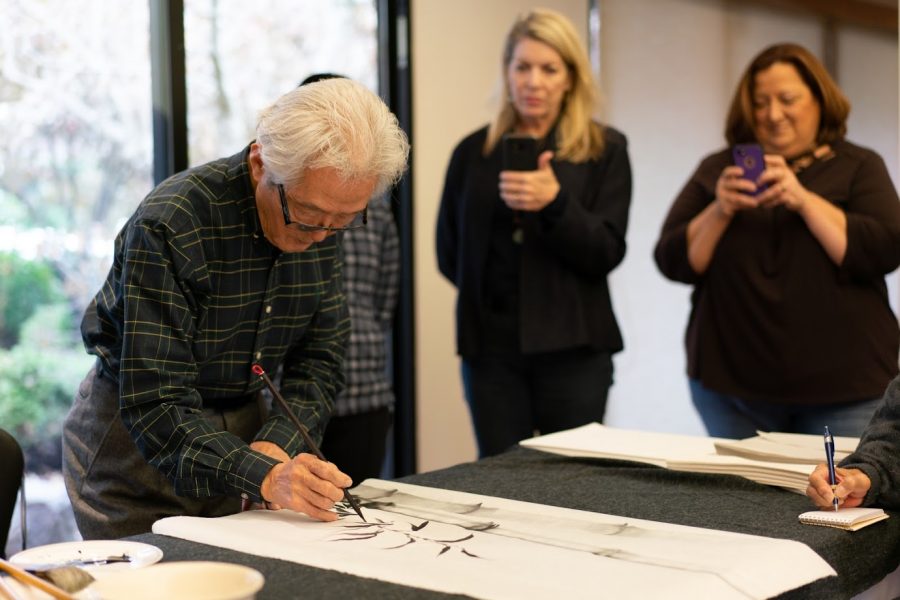Japan House ink painting class channels Zen philosophy
Professor Shazo Sato explains how to paint bamboos with black ink in his black ink painting class at the Japan House on Sunday. In addition to courses taught this fall, a second eight week class on Japanese calligraphy will be offered in fall of 2020.
Nov 21, 2019
Last updated on Nov. 26, 2019 at 03:22 p.m.
Japan House is holding a series of sumi-e, or black ink painting, courses in November and December. These lessons are taught by Shozo Sato, professor in FAA and founder of Japan House.
Black ink painting courses were offered on Nov. 3 and Nov. 17, and two more will be offered on Dec. 1 and Dec. 8. The courses are interspersed with calligraphy lessons, also taught by Sato, that will run through January and February. A Japanese calligraphy class will also come to the University in fall 2020 as a second eight-week course.
Jennifer Gunji-Ballsrud, director of Japan House, said that every cultural event at Japan House offers some way for attendees to participate.
“Our mission is to share Japanese arts and culture with the broader campus and also the community,” Gunji-Ballsrud said. “Japan House gives an opportunity for people to experience Japanese culture in a very authentic and immersive learning environment, whether through classes, workshops, presentations or our Japanese festival.”
Get The Daily Illini in your inbox!
Japan House also runs an array of other events throughout the year, including the annual Matsuri, a Japanese festival held in September.
“What we teach is all about reconnecting with nature, reconnecting with the self, disconnecting with your phone and social media and all these things so we can just be,” Gunji-Ballsrud said.
Japan House is located around the Arboretum, providing a natural atmosphere.
“I knew my life was for being an artist,” Sato said. “At the age of 12, I asked to become a student of a very famous Japanese artist in Kyoto, a mecca of Japanese art. He said ‘no, we don’t want to take kids.’ But I went there every day for three weeks, begging to become a student. And then I became a student and learned all the foundational Japanese art.”
In addition to founding Japan House, Sato is a former artist-in-residence at Krannert Center.
He worked to create Kabuki theater adaptations of Western works, such as Achilles: A Kabuki Play. He said this was effective because American audiences already knew the story and plot, so they could more easily perceive the differences between American or Western theater and Japanese Kabuki theater.
Sato completed a degree in oil painting and abstract art, as well as studied Kabuki dance and ballet, at a time when American and modern art were becoming contemporary in Japan.
“Japanese art is admiring active, empty space, making it as simple as possible, like haiku poetry,” he said. “But American, Western art — you cannot leave white canvas. You must cover the whole surface.”
Sato’s various fine arts classes, from Kabuki and tea ceremonies to calligraphy and sumi-e, emphasize the principle of Zen philosophy. Sumi-e’s seemingly limited concept of painting with only black ink captures the philosophy well, Sato said.
“In sumi-e, there is no color, but suggesting the subject in a very realistic formation with black ink will lead the viewer to fill in the sense of color. You cannot erase black ink. You have to put in full energy. That is Zen. Every minute you have pass, you have to live fully. Unlike calligraphy, the important part of sumi-e isn’t a word, but the visual effect of nature as a way that Zen philosophy can be understood,” Sato said.
Sato also used the analogy of a two-key keyboard for the idea of sumi-e. With an apparently limited range, you can create art through the entire range of human emotion.
“The Japanese traditional arts have become wider, but they still have that core Zen philosophy; that’s something you cannot change,” Sato said.






